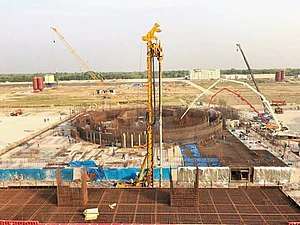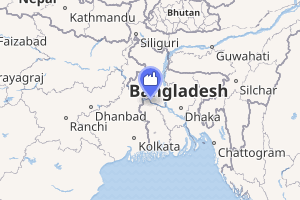Rooppur Nuclear Power Plant
The Rooppur Nuclear Power Plant will be a 2.4 GWe nuclear power plant in Bangladesh. The nuclear power plant is being constructed at Rooppur (Ruppur), adjoining Paksey, in the Ishwardi Upazila of Pabna District, on the bank of the river Padma, 87 miles (140 km) west of Dhaka, in the northwest of the country.[1] It will be the country's first nuclear power plant, and the first of two units are expected to go into operation in 2023.[2][3][4] It is being built by India's Atomic Energy Commission[5][6][7][8][9] and the Russian Rosatom State Atomic Energy Corporation.[3]
| Rooppur Nuclear Power Plant | |
|---|---|
 Rooppur Nuclear Power Plant under construction on 29 August 2018 | |

| |
| Country | Bangladesh |
| Location | Rooppur, Ishwardi, Pabna Bangladesh |
| Coordinates | 24°4′0″N 89°2′50″E |
| Status | Under construction |
| Construction began | 30 November 2017 |
| Construction cost | $12.65 billion |
| Owner(s) | Bangladesh Atomic Energy Commission |
| Operator(s) | Nuclear Power Plant Company Bangladesh Limited |
| Nuclear power station | |
| Reactor type | PWR |
| Cooling towers | 2 × Natural Draft |
| Cooling source | Padma River |
| Thermal capacity | 2 × 3,200 MWth |
| Power generation | |
| Make and model | VVER-1200/523 |
| Units under const. | 2 × 1,200 MW (gross) |
| Nameplate capacity | 2,160 MW |
| External links | |
| Website | www |
| Commons | Related media on Commons |
History
The plan to establish a nuclear power plant in the then East Pakistan was made in 1961.[10] In 1963, the Rooppur village of the Pabna district was selected for the proposed plant and 254 acres (103 ha) of land was acquired. The plan was to establish a 200MW nuclear power plant in the selected site. Discussions took place with the Government of Canada from 1964 to 1966. Discussions with the governments of Sweden and Norway were also going on in those years. However, no real progress was made. In 1970, the project was scrapped.
After the independence of Bangladesh, the Government of Bangladesh started discussion with the Soviet Union in 1974, however no agreement was reached. In 1976-77, French company Sofratom conducted a feasibility study and found the project at Rooppur feasible. In 1980, a 125 MW nuclear power plant project was approved. But, this effort did not materialized too.
In the 1987-88 period, another feasibility study was conducted and decision was taken to construct a 300 to 500 MW nuclear power plant. In 1998, steps were taken to construct a 600 MW power plant. Nuclear action plan was approved in 2000.
In 2005, Bangladesh signed a nuclear cooperation agreement with China. In 2007, the Bangladesh Atomic Energy Commission (BAEC) proposed two 500 MW nuclear reactors for Rooppur by 2015. In 2008, China offered funding for the project.
In 2009 the Bangladesh government again started discussion with the Russian government and on 13 February the two governments signed a memorandum of understanding. Rosatom said they would start construction by 2013.[11][12][13][14][15]
In 2011, International Atomic Energy Agency conducted IAEA Integrated Nuclear Infrastructure Review (INIR) mission in Bangladesh. Later on, IAEA approved a technical assistance project for the Rooppur nuclear power plant.
In 2013 a group of Bangladeshi scientists and the global diaspora voiced profound concern over the safety and economic viability of the plant.[16] Several separate issues were raised, from the unsuitability of the site to the obsolescence of the VVER-1000 model proposed, questionable financing arrangements and a lack of agreement with Russia over nuclear waste disposal.[17]
In 2015 the proposal was delayed by a year. Rosatom offered a two VVER-1200 reactor power plant, increasing output to 2.4 GWe.[3]
By December 2015 The Daily Star reported that the estimated cost of the plant had climbed to US$13 billion, from statements of around US$4 billion made earlier in the same year.[18] German based Transparency International expressed concern on 28 December 2015 about the safety of the proposed plant.[18]
In 2016 ground preparation work commenced. The $12.65 billion contract is 90% funded by a loan from the Russian government. The two units generating 2.4 GWe are planned to be operational in 2023 and 2024. Rosatom will operate the units for the first year before handing over to Bangladeshi operators. Russia will supply the nuclear fuel and take back spent nuclear fuel.[19]
On 4 November 2017, Bangladesh Atomic Energy Commission received, from Bangladesh Atomic Energy Regulatory Authority, the design and construction license of Unit 1, paving the way for the nuclear island first concrete pour.[20][21]
At the 61st general conference of the global nuclear watchdog International Atomic Energy Agency (IAEA), Mr. Shekhar Basu (Chairman, Atomic Energy Commission of India) mentioned that India is also involved in this project with Russia, however, the level of Indian involvement (collaboration) in this project has not been established yet, as India is not a member of the Nuclear Supplier Group (NSG), which controls the export of materials, equipment and technology that can be used to manufacture nukes.[22][23][24]
On 30 November 2017, first concrete was poured for the nuclear island basemat of Unit 1. A ceremony was held, attended by Rosatom's director-general Alexey Likhachev and the prime minister of Bangladesh Sheikh Hasina.[25] On 14 July 2018, first concrete was poured for Unit 2.[26] The following month, Rosatom began installing a 200-tonne core catcher as the first large piece of equipment in the reactor building of Rooppur 1, describing it as "a unique protection system".[27]
Planned nuclear power reactors
| Unit | Type | Capacity (gross) | Construction start | Operation | Notes |
|---|---|---|---|---|---|
| Rooppur 1 | VVER-1200/523 | 1200 MWe | 30 November 2017 | 2023 | [28] |
| Rooppur 2 | VVER-1200/523 | 1200 MWe | 14 July 2018 | 2024 | [29] |
Research
Bangladesh's development strategy sees the country becoming a middle-income nation by 2021, in large part by emphasis on its science and technology sector to drive economic growth. The ministry of science and technology (MoST) estimated in 2014 that US$6.2 billion will be needed in the next decade to achieve the goals of Vision 2021. The Science and Technology Act 2010 is helping to boost this, and MoST is now allocating over $150 million per year to nuclear technology development as gas reserves become depleted. The power plant will also promote the local economy of Rooppur, Pabna.
The country has had a TRIGA 3 MW research reactor operational since 1986.[30]
See also
- Nuclear energy in Bangladesh
- Kaptai dam
- Mymensingh Power Station
- Matarbari Power Plant
- Payra Power Plant
- Raozan Power Plant
- Rampal Power Station
References
- "Russian loan for Rooppur construction". World Nuclear News. 16 January 2013. Retrieved 24 May 2013.
- "Cabinet clears draft law to form company to operate Rooppur nuclear power plant". bdnews24.com. 4 May 2015. Retrieved 6 June 2015.
- "Delay for Bangladesh nuclear plant". World Nuclear News. 20 October 2015. Retrieved 26 October 2015.
- "Rooppur nuclear deal signed with Russia", The Financial Express, Dhaka, 25 December 2015, archived from the original on 26 December 2015, retrieved 27 December 2015
- antipin, alex (2018-11-29). "Indian industry participates in construction of Rooppur Nuclear Power Plant in Bangladesh". NuclearAsia. Retrieved 2020-02-18.
- PTI (2018-03-01). "India, Russia, Bangladesh sign pact for Rooppur atomic plant". Livemint. Retrieved 2020-02-18.
- "India to assist in Rooppur implementation - World Nuclear News". www.world-nuclear-news.org. Retrieved 2020-02-18.
- kondratieva, ksenia. "Indian companies to tap $-1 bn opportunity in Bangladesh's nuclear project". @businessline. Retrieved 2020-02-18.
- Chaudhury, Dipanjan Roy (2017-09-30). "India plays major role in nuclear plant in Bangladesh". The Economic Times. Retrieved 2020-02-18.
- "Nuclear Power in Bangladesh", World Nuclear Association, retrieved 1 January 2016
- Mahbub, Sumon (15 January 2013). "N-plant funding deal cut". bdnews24.
- "PM seeks more Russian investment in ICT sector". The News Today. 15 January 2013.
- "Collaboration in defence, telecom agreed upon". The News Today. 15 January 2013.
- "Bangladesh agrees nuclear power deal with Russia". BBC News. 2 November 2011.
- "Bangladesh to Get $1Bln Loan for Weapons". The Moscow Times. 16 January 2013.
- , Voice for Justice World Forum, 30 June 2013
- Karmaker, Arun (23 July 2015). "Rooppur Plant reactor technology being changed". Prothom Alo. Retrieved 19 July 2016.
- "TIB concerned over Rooppur nuke plant's safety", The Daily Star, 28 December 2015
- "Contract signed for preparatory work at Bangladesh's NPP". Nuclear Engineering International. 1 April 2016. Retrieved 4 April 2016.
- "Rooppur gets design, construction licence". The Daily Star. 5 November 2017. Archived from the original on 4 November 2017. Retrieved 6 November 2017.
- "BD To Pour First Concrete For Its Rooppur NPP On November, 30". energybangla.com. 2 November 2017. Retrieved 30 November 2017.
- "India's First Atomic Energy Venture Abroad Is Bangladesh's First N-Plant". NDTV. 30 November 2017.
- "India collaborating with Russia for nuclear power plant in Bangladesh". The Indian Express. 20 September 2017.
- "India Collaborating With Russia For Nuclear Power Plant In Bangladesh". NDTV. Press Trust of India. 20 September 2017.
- "First Concrete Poured For Unit 1 At Bangladesh's Rooppur". nucnet.org. NucNet a.s.b.l Brussels. 30 November 2017. Retrieved 30 November 2017.
- "Construction starts on second Bangladeshi reactor". World Nuclear News. WNA. 16 July 2018. Retrieved 8 August 2018.
- "Core catcher installation under way at Rooppur 1". World Nuclear News. Retrieved 5 June 2019.
- "ROOPPUR-1". Power Reactor Information System. International Atomic Energy Agency. 8 August 2018. Retrieved 8 August 2018.
- "ROOPPUR-2". Power Reactor Information System. International Atomic Energy Agency. 8 August 2018. Retrieved 8 August 2018.
- Nuclear Power in Bangladesh